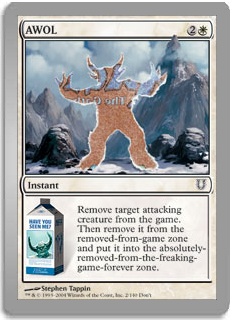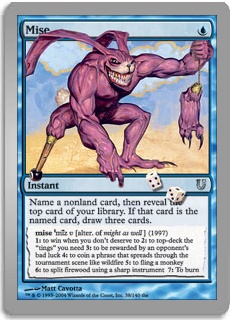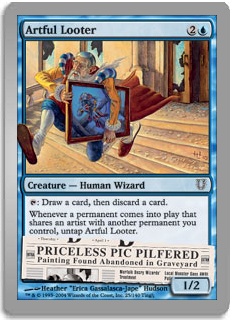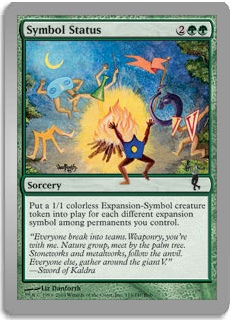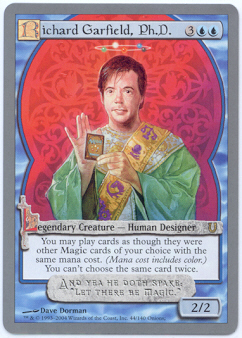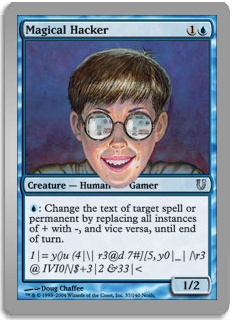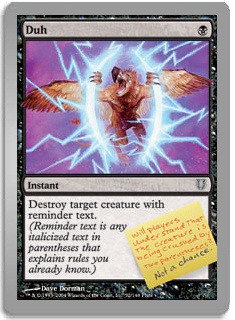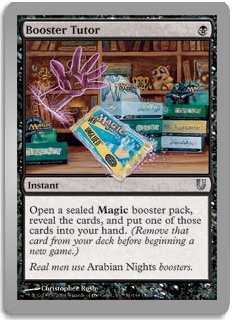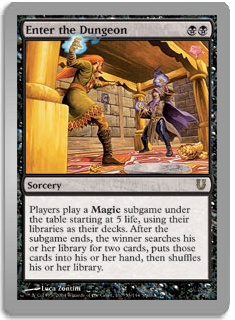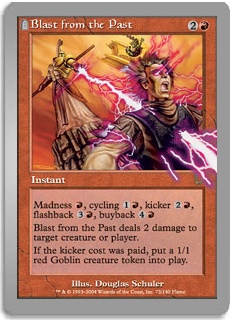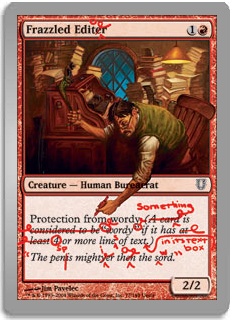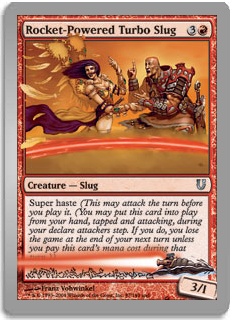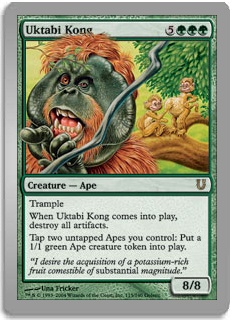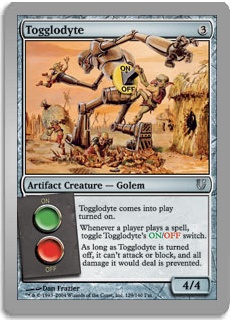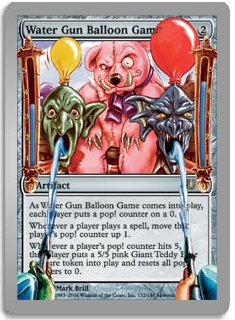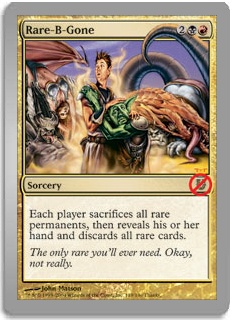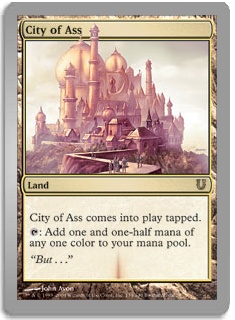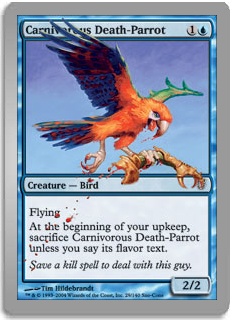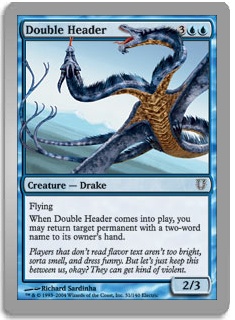Cube is a mostly unsanctioned format aside from the Magic Online Cube and various events like the Player’s Championship using the Magic Online Cube and sanctioning Cube through the WPN network (but even then, that’s only really for casual Planeswalker Points). Because of this, cube designers don’t have to adhere to rules that are required for building decks for sanctioned Magic like Standard or Modern. This allows them to put cards in their cubes like Holiday promos and cards from the Un-sets that can’t be used in sanctioned Magic. In this article, I’ll discuss some of those cards that are frequently found in cubes.
Gifts Given
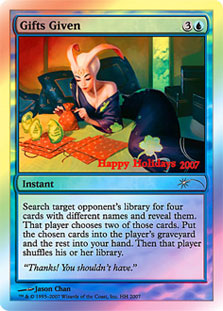
Gifts Given may very well be the best Un-card in Cube, especially in a deck that can reliably cast spells from the opponent’s deck (since it generally gets picked quickly in drafts, you can easily focus later picks on mana fixing to make sure that you can cast opposing spells) because it removes the threats from the opponent’s deck. Usually, its worst-case scenario is as a 4x Extract type of effect/generic draw effect ala Deep Analysis, and it being splashable helps a drafter who takes it early put it in just about any deck.
AWOL and Fowl Play
Neither of these is very good, even in a pauper cube, as three-mana removal in any format needs to do something like have a body attached to be worthwhile. Fowl Play may look better since it’s in a color that doesn’t have a lot of direct cheap creature kill, but it’s still essentially a worse Crib Swap. Creature theft effects and bounce effects make it so that running a card as suboptimal as Fowl Play shouldn’t be necessary even if it has an occasional nice interaction, like turning an Elesh Norn or Griselbrand into a Chicken where stealing/bouncing it may have caused you to lose.
Mise
Although the potential payout on Mise is huge as a draw three for one, it’s overly reliant on being able to control the top card of your deck. Cards like the miracle cards (Entreat the Angels, Bonfire of the Damned) retain usefulness by being decent in non-miracle mode, but unfortunately, due to the nonland restriction on Mise, it’s very hard to come out ahead.
Artful Looter and Symbol Status
Both of these cards can be corrected so that the artist of each basic land can be considered as the same artist (like John Avon) or so that each basic land has a different artist. Or you could just get a basic land from as many sets as possible. Symbol Status is the better of the two as it’s essentially an upgrade to Beacon of Creation, but you could use Artful Looter for Reanimation support if need be. Unfortunately, this is a case where using errata for different cards can be confusing, so it’s best to choose between the two rather than try to make a form of errata for artist credit where both conditions are satisfied.
Richard Garfield, Ph. D
Dr. Garfield is one of those “if you untap with it, you win”/ fails the Terminate test type of cards. About five years ago, those types of cards were much better since cubes were slower, but with many cubes adopting aggressive strategies and getting more efficient removal options, things like the “Vindicate test” (where you get an effect out of it if the creature dies at sorcery speed, so Consecrated Sphinx passes that test) hamper its effectiveness, but it does protect itself well if you are able to untap with it since you can turn just about any blue card into a counterspell or draw card.
Magical Hacker
Magical Hacker is somewhat like an exaggerated version of Contagion Clasp—a card that’s mainly used because of its interactions with other cards, mainly planeswalkers. It’s a card like Squee in that it generally won’t make every deck, but a deck that can use it (a deck with at least a few high-quality interactions; it’s difficult to say how useful the ability to turn Skinrender’s -1/-1 counters into +1/+1 counters will be in a Cube deck). Still, like Squee, it’s a card that isn’t necessarily a build around but that works very well with others (especially Chandra Nalaar).
Duh
Unfortunately, I’ve found that when I’ve drafted this in other cubes, it generally failed to impress as there weren’t enough targets for me to make use out of it. One-mana removal is hard to come by in black, but it still usually didn’t do enough, especially when compared to cards like Tragic Slip and even Ghastly Demise. It’s interesting to note that if you want to make the card get more incidental value, some versions of cards from the Portal sets have reminder text, like the Portal 2 version of Ravenous Rats (although I don’t think that has a home, even in pauper cubes).
Booster Tutor
There are several ways to play Booster Tutor in Cube, but the most common way is for someone to take fifteen undrafted cards from the cube (or fourteen plus a random basic land) for the booster pack, although using an actual booster pack is acceptable as well (which I’ve seen in Eric McCormick’s cube). It’s essentially taking a first pick in the middle of a game. Depending on the deck, it can either be a solid value card or a card resembling Demonic / Vampiric Tutor. Much like Gifts Given, it’s a card that should be taken early and if so can be built around by taking incidental mana fixers to support it, like a Golgari Rot Farm in a B/U control deck. I’ve first picked it many a time and have always been happy with it. Due to its splashability, I usually ended up splashing it.
Enter the Dungeon
Enter the Dungeon is a solid card for black aggro decks, especially B/R ones that aim to end the game by turn 2 or 3 with quick damage before the opponent knows what’s going on. Although I absolutely loved Booster Tutor and took it highly, one of the major annoyances with the card was the logistics of it—having to get my cube from the other side of the table and have people pass it generally frustrated people. Enter The Dungeon is worse in that regard by having to set up another game, but usually the games end quickly at least.
Blast from the Past
Unfortunately, as much as I would have loved for this card to printed in Time Spiral block since it doesn’t really break any rules (so I could play it in my cube, as I use no Un-cards,) alas, it wasn’t meant to be. For cubes that allow Un-Cards, it’s definitely one of the strongest red cards and a staple. Typically, it gets played for its cycling + madness cost ala Ichor Slick from TSP Limited and flashes back, but it has surprisingly high flexibility for such a good card (note that you can’t buy it back when it’s being flashed back as it gets auto-exiled, but you can do things like cycling + madness + buyback if the game goes long). Its most often used mode is almost like a mono-colored Electrolyze, which trades the ability to split for flashback.
Frazzled Editor
The Editor isn’t as important for cubes that allow for Un-cards as it was in the days before Gore-House Chainwalker, Ash Zealot, Lightning Mauler, and Torch Fiend. Regardless, it’s still a solid beater that gets through a lot of creatures typically used to stop aggro beaters like Wurmcoil Engine and Solemn Simulacrum. Unfortunately, it’s a nombo with a lot of cube-worthy equipment like all of the Mirrodin / Scars Swords, Grafted Wargear, and Umezawa’s Jitte, but them’s the breaks. Like when you have to run Vampire Nighthawk in the same deck as Sulfuric Vortex, sometimes you have to run cards that have some nombos.
Rocket-Powered Turbo Slug
Although this was the inspiration for the Future Sight Pact cycle, this is what Pact of the Titan should have been since its aggressive nature fits that color better than the 4/4 did. With cards like Hellrider kicking out other recent four-drops like Moltensteel Dragon (which is actually a four-drop) and red getting more curve-toppers like Thundermaw Hellkite and Zealous Conscripts, RPTS is another card that was better years ago as it was a curve-topper that could be supplemented by another three or four mana spell at the top of the curve when you alpha striked. As I consider the Slug a four-drop, competition is too tight nowadays.
Gerrymandering
Gerrymandering is interesting because it’s one of the cheaper Geddon type of effects, but it’s generally closer to something like Natural Balance, which punishes players for overextending on lands, rather than being a door-slamming game ender. It can be utilized better in decks with lots of mana rocks to mitigate the loss of your own lands. The lands entering the battlefield untapped is nice, but it still feels like it falls short.
Uktabi Kong
I could be more gung-ho about this card as I was ages ago, but even a green section of a cube that’s going deep into supporting ramp doesn’t really need Uktabi Kong in a world with Terastodon, Woodfall Primus, and Craterhoof Behemoth. It’s nice to have cards to support cards like Natural Order or other Reanimation spells, but having a fourth eight mana green creature isn’t really necessary.
Jack-in-the-Mox
Sometimes, I see people who are new to Cube shy away from taking off-color Moxes, but this is incorrect since even a colorless Mox is easily a high pick that should go into any deck. Jack-in-the-Mox works in a similar fashion—it can backfire 1/6 of the time, but it often makes mana just as well as the average Mox. I would probably take it higher than something like Chrome Mox in a pack, and it’s a card that I tend to see underused in cubes that allow Un-cards.
Togglodyte
When I cut the Un-cards from my cube, Blast from the Past, Booster Tutor, and Togglodyte were the ones that I missed the most. Its drawback may look like it’s very punishing and can allow the opponent to surprise you via a mid-combat spell, but I never really saw that scenario play out since its damage prevention ability is a “a conditional static ability so as long as it’s on when damage is dealt, it won’t be prevented.” (Thank you, @fenaris!)
It usually plays out somewhat like a colorless Ashenmoor Gouger / Chimeric Idol where you typically don’t bother trying to block with it (why am I blocking with my aggro guys anyway?) and, if need be, you cast a spell pre-combat to activate it (typically I used a large coin, like a quarter, to denote whether it was “on” or “off”). Like Chimeric Idol, it may cause you to play in an odd manner, but it’s not enough to make the drawback bad or getting around the drawback not worth it due to the efficiency.
Water Gun Balloon Game
Water Gun Balloon Game was a card that I considered in the early days of my cube, but it’s probably too niche for many lists. Its best use seems to be either as a storm support card or in decks that can break the parity (with lots of cheap spells / creatures / cantrips that can cycle into each other), but I’m honestly not a huge fan of it.
Rare-B-Gone
If you’ve listened to The Third Power podcast, you’ll have noted that my co-host Anthony Avitollo uses Rare-B-Gone because it’s a great build around card in an archetype like B/R Aggro. Like with Frazzled Editor, there may be some nombo potential, but it’s generally worth it as it usually acts like a one-sided Apocalypse or a more devastating Void.
Who / What / Where / When / Why
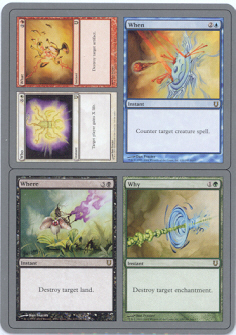
5W is like a lot of flexible cards in that it isn’t really efficient at doing anything specifically because each mode costs one more mana than the general cost (1R is the general cost of a Shatter effect, but on “What” it costs 2R) aside from the Stream of Life mode on “Who,” which is pretty suboptimal. There are some interesting interactions like with Isochron Scepter and Chrome Mox, but it’s mainly used like a card like Burst Lightning where its flexibility more than makes up for the lack of efficiency.
City of Ass
Essentially, City of Ass is a better version of a Vivid land or Grand Coliseum, giving rainbow mana every turn at the cost of entering the battlefield tapped. Assuming that you have no qualms about using Un-cards, City of Ass is a pretty easy inclusion.
Carnivorous Death-Parrot, Vile Bile, The Fallen Apart, Paper Tiger, Scissors Lizard, Rock Lobster, Double Header
These Un-cards are considered mainly for pauper cubes since their power to toughness isn’t special in cubes that allow for rares, but four power and a decent toughness for four is actually pretty hard to find outside of a few cards like Rhox Brute, Wildheart Invoker, and Windrider Eel (which is actually a 4/4). Death-Parrot and Vile Bile are cheap creatures for pauper, with Vile Bile being essentially a drawback-less Erg Raiders (since Thrill-Kill Assassin is an uncommon).
Double Header is interesting since many cards in pauper cube tend to have exactly two words, like Ulamog’s Crusher and Izzet Boilerworks. The density goes down in cubes with rares where like Riftwing Cloudskate is better anyway. Still, for pauper cubes it’s a good card to note, especially since the only other good ETB permanent bouncing creature is Aethersnipe.
Blacker Lotus
Blacker Lotus is generally corrected so that it just exiles itself to make four mana. If so, it may be the best Un-card and second only to the fixed Contract from Below (which instead of putting another card into Ante exiles a card).
Although the use of Un-cards is uncommon in many cubes, I hope that this article has inspired you to look into using these unusual cards in your cube.
May all of your opening packs contain Sol Rings!
@UsmanTheRad on Twitter
http://idratherbecubing.wordpress.com – my blog featuring my regular cube and pauper cube
The Third Power: A Cube podcast featuring myself and Anthony Avitollo!

